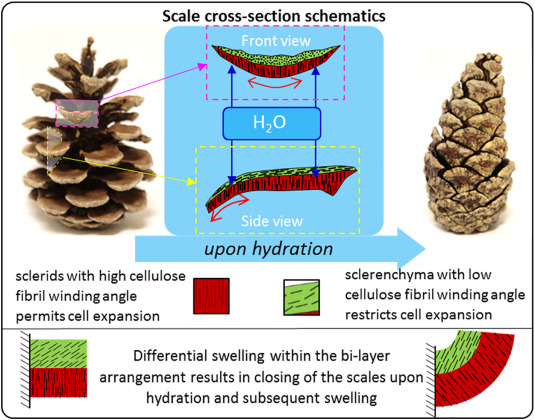New research published in Materials & Design journal applies natural materials to 4D printing for truly bioinspired objects.
In this development, a team from the University of Bristol and University of Bath, creates a 3D printed ink that harnesses cellulose fibers to transform in response to water.
The research is inspired by the natural behavior of pine cones, and lays new groundwork for the future development of smarter, self-assembling materials.

4D printing next gen smart materials
As one next-stage development of 3D printing, the term 4D printing has grown in popularity in recent years, even earning itself a position “On the Rise” in Gartner’s 2018 Hype Cycle for 3D Printing.
Put simply, 4D printing refers to a process in which an object is 3D printed to contain shape memory elements. When a stimulus is applied to such an object, it is then capable of transforming into a new shape and, often, returning to its original state afterwards. One example, as used in other 4D printing studies, is 3D printing a flat net of flower petals that, when heated/added to water, close up into a bud.
Many 4D printing experiments rely on tuneable stresses in a 3D printed object to transform. In Bristol/Bath’s case however, it is the exact material composition that allows its 3D printed objects to transform.
Biomimcry at its best
Cellulose, the most abundant organic polymer on Earth, is highly absorbent. As detailed in the diagram below, cellulose fibrils within the cell walls of a pine cone are responsible for its ability to close when in contact with water.

The process is described in the research as follows:
“Strain mismatch within a substrate is the driving force for many of the transformations in nature as well as for many synthetic actuators upon activation by the stimuli. Swelling is one of the simplest way to realize strain differential in a substrate.”
This property is synthetically imitated by the team in an ink combining a basic hydrogel with cellulose pulp and clay particles for increased absorption and nozzle flow.
Programmable plastics
By creating an cellulostic ink that successfully transforms when hydrated or dehydrated, the researchers at Bath and Bristol have opened up new avenues for exploring the programmability of materials.
In conclusion, the authors state their aims; “The demonstration of a sustainable and cost-effective ink which is able to be used with commercial 3D printers is expected to encourage the widespread adoption of 4D printing,”
“This should accelerate our understanding of the fundamental design principles by making 4D printing more accessible and attractive to a greater number of researchers.”

“Responsive cellulose-hydrogel composite ink for 4D printing” is available to read, open-access, here. The paper is co-authored by Manu C. Mulakkal, Richard S. Trask, Valeska P. Ting and Annela M.Seddon.
For more of the latest additive manufacturing research, sign up to the 3D Printing Industry newsletter follow us on Twitter, and like us on Facebook.
On the lookout for new talent or seeking a career change? Search and post 3D Printing Jobs for opportunities and new talent across engineering, marketing, sales and more.
Featured image shows timelapse of a pine cone’s transformation in water. Clip via madm4tty on YouTube.


